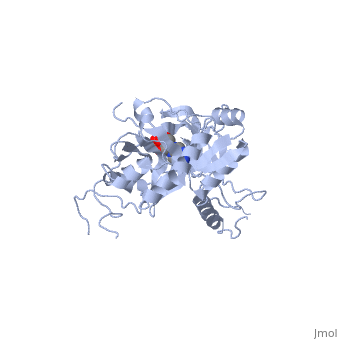ATP-Dependent DNA Ligase (Bacteriophage T7)
From Proteopedia
ATP-DEPENDENT DNA LIGASE FROM BACTERIOPHAGE T7
Overview (General Function)ATP-dependent DNA ligase from bacteriophage T7 (Caudovirales Podoviridae[1]) is used to catalyze a phosphodiester bond between single-strand nicks in double-stranded DNA. This occurs in replication (connecting okazaki fragments)[2], DNA repair (excision repair), and recombination. DNA ligases require either ATP (eukaryotes and viruses) or NAD+ (prokaryotes) as a cofactor[3]. All ligases require a divalent cation for function. Bacteriophage T7 DNA ligase uses Magnesium in vivo. A range of pH 7.2-7.7 is ideal for enzymatic activity. T7 ligase has a molecular weight of 41 kDa[4].
StructureATP-dependent DNA ligase from bacteriophage T7 is monomeric, forming a tertiary structure consisting of two domains (domain 1 and domain 2). Domain 1 (residues 2:240) contains the ATP binding site. Domain 1 is composed of six alpha helices which surround three antiparallel Beta sheets. Domain 2 (residues 241:349) is composed of an antiparallel Beta sheet and an alpha helix[4]. A groove is formed between the two domains; this groove allows ATP to bind with domain 1. The ribose ring of ATP forms hydrogen bonds with the side chains of Arg-39, Arg-55, and Glu-93. Lys-232, Lys-238, and Lys-34 (the catalytic residue) form hydrogen bonds with the three phosphoryl groups of ATP. The 6-amino group of the adenine ring creates hydrogen bonds with the main-chain carbonyl of Ile-33 and the side chain of Glu-32. This could account for the use of ATP rather than GTP. While consisting of 359 residues, residues 121-127, 307-316, and 350-359 are not easily deciphered from the crystalline structure, and are therefore left out of the diagram[4]. Domain 1 contains the N terminus, while domain 2 contains the C terminus. Multiple N and C terminii are shown in the diagram due to the missing residues. main-chain carbonyl of Ile-33 and the side chain of Glu-32
Catalytic function with DNAATP-dependent DNA ligase from bacteriophage T7 amends a fractured DNA strand through esterification of a 5'- phosphoryl to a 3'- hydroxyl group[3]. This mechanism occurs with the aid of ATP in several steps. First, the ligase is activated through a phosphoramidate bond with a lysine residue in the active site (Lys 34). A pyrophosphate leaves and the enzyme-AMP complex is formed. Next, the AMP is transferred to the 5' phosphate group at the nick in the DNA. Finally, T7 ligase creates the phosphodiester bond between the 5' -phosphoryl and the 3' – hydroxyl group, with AMP being freed[4]. All ATP-dependent DNA ligases contain a conserved amino acid sequence of KxDGxR[3]. This includes the lysine residue which binds the ATP in the groove between the two domains.
|
| ||||||||||
References
- ↑ McGrath S, van Sinderen D. Bacteriophage: Genetics and Molecular Biology. Norfolk: Caister Academic Press, 2007. Print.
- ↑ Berg, Jeremy M, Stryer, Lubert, Tymoczko, John L. Biochemistry. Sixth edition. New York: W.H. Freeman and Company, 2007: 796. Print.
- ↑ 3.0 3.1 3.2 Doherty AJ, Ashford SR, Subramanya HS, Wigley DB. Bacteriophage T7 DNA ligase. Overexpression, purification, crystallization, and characterization. J Biol Chem. 1996 May 10;271(19):11083-9. PMID:8626651
- ↑ 4.0 4.1 4.2 4.3 Subramanya HS, Doherty AJ, Ashford SR, Wigley DB. Crystal structure of an ATP-dependent DNA ligase from bacteriophage T7. Cell. 1996 May 17;85(4):607-15. PMID:8653795

